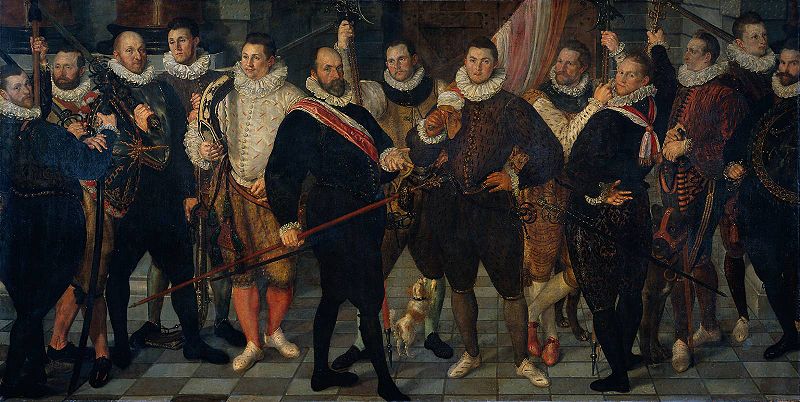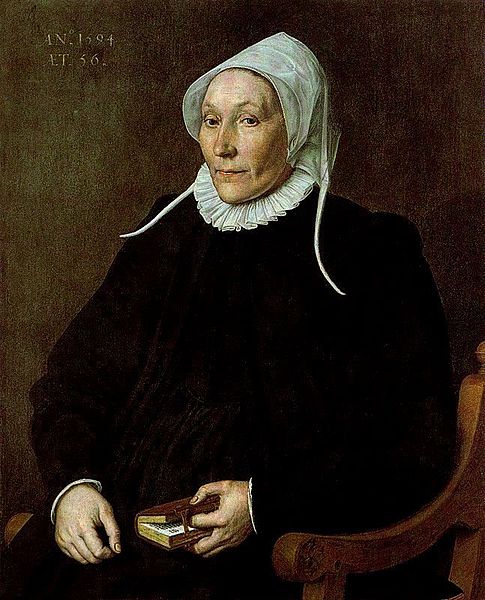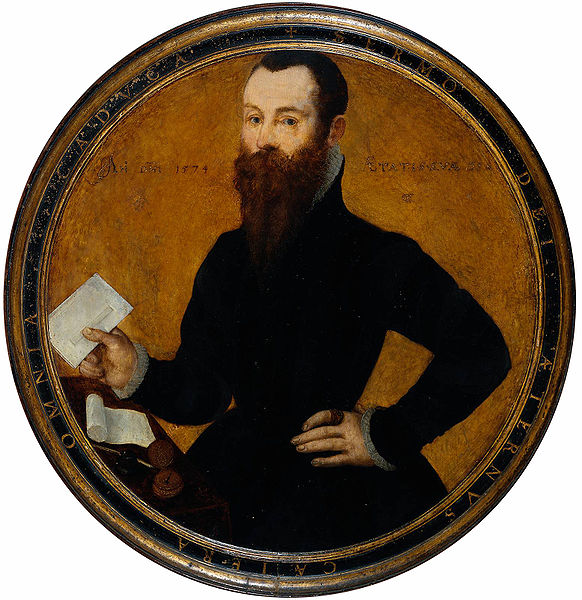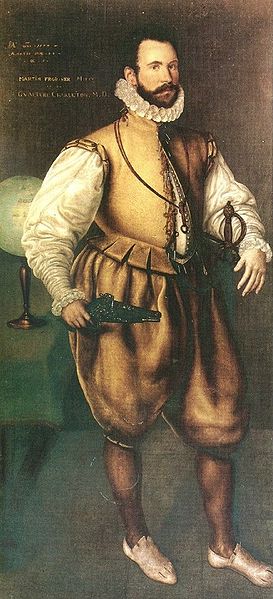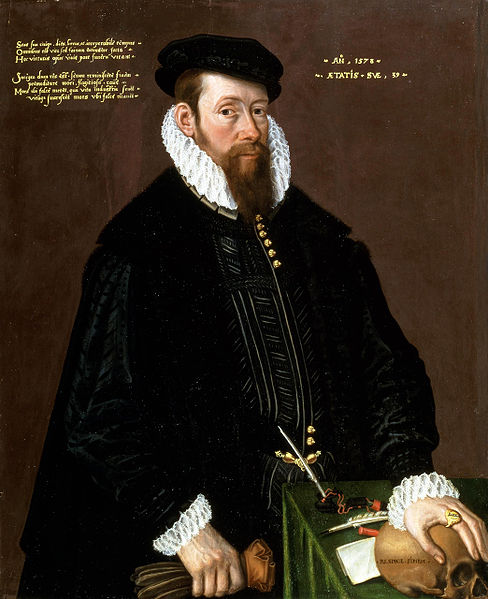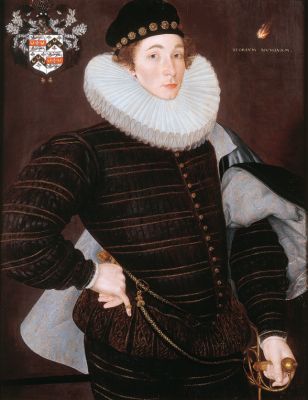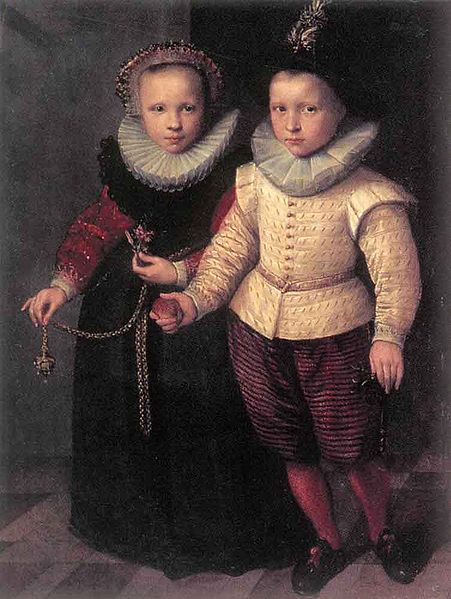<Back to Index>
- Historian Manuel de Faria e Sousa, 1590
- Painter Cornelis Ketel, 1548
- 22nd and 24th President of the United States Stephen Grover Cleveland, 1837
PAGE SPONSOR
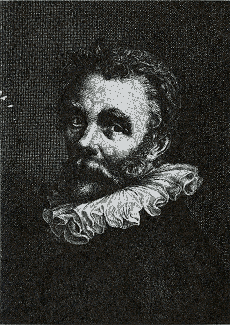
Cornelis or Cornelius Ketel (18 March 1548 – 8 August 1616) was a Dutch Mannerist painter, active in Elizabethan London from 1573 to 1581, and in Amsterdam from 1581 to the early 17th century, now known essentially as a portrait - painter, though he was also a poet and orator, and from 1595 began to sculpt as well.
According to Ketel's biography, written by his contemporary Karel van Mander, he seems to have wanted to concentrate on the most prestigious of the hierarchy of genres, history painting,
which included mythological subjects, but after he left France he is
known almost entirely as a portrait - painter. Neither England nor
Holland had much demand for large history paintings during his
lifetime, and none of Ketel's histories or allegorical paintings are
known to have survived intact, although drawings and prints survive. He did however significantly influence the development of the largest type of painting commonly produced in the United Provinces at this period, the civic group portrait. Ketel was born out of wedlock in Gouda in 1548 and apprenticed to his uncle Cornelis Jacobsz. Ketel (died c. 1568) at age 11. He is said to have been encouraged to pursue a career in painting by the stained glass painter Dirck Crabeth, whose brother Wouter's wife may have been related to Ketel. He studied under Anthonie Blocklandt in Delft, c. 1565, before travelling to Paris where he lived with Jean de la Hame, glass - painter to King Charles IX. From Paris he went to Fontainebleau, where he was working in 1566, in the final years of the First School of Fontainebleau, a sojourn which was no doubt decisive in forming his taste for Mannerist allegory. He was forced to leave France in 1567 when all citizens of the Habsburg Netherlands were expelled. He returned to Gouda, but the economy there was severely hit by the occupation of the city in 1572 by the Geuzen or rebels, followed in 1573 by a plague which killed 20% of the population; the Dutch Revolt was entering a new and deeper phase that destabilised daily life throughout the Netherlands. By 1573 Ketel is recorded in England, and was one of several exiled Netherlandish artists active at the Tudor court in the 1570s. His friend Carel van Mander notes his portrait of Sir Christopher Hatton, of the Earl of Oxford, and various noblemen, their wives and children. In 1578, permission was granted for a portrait of Queen Elizabeth, when on a visit to the duchess of Somerset at Hamworth House. Finding
no market in England for his preferred allegorical subjects, Ketel
returned to the Low Countries before 1581, where he later introduced
the full - length group portrait format to the Dutch burghers with
great
success, and
seems still to have been mostly commissioned as a portraitist. The
Dutch taste emerging from the revolt was hostile to Mannerist allegory
and even to simpler mythological subjects in art, which were widely
associated with the hated Habsburgs, the rulers against whom the Dutch were rebelling. He also painted some religious subjects. Cornelis van der Voort (born ca. 1576) is thought to have been a pupil of Ketel's; he became a successful Amsterdam portraitist. The Danish - born Pieter Isaacsz was certainly a pupil, and van Mander mentions others. The early 18th century Gouda historian Ignatius Walvis says that the artist Wouter Pietersz. Crabeth (1594 – 1644), grandson and namesake of the glass - painter, studied under Ketel. Ketel suffered a stroke in 1613 and died in Amsterdam in 1616.
Ketel
quickly established himself as a successful painter of portraits in
London. Karel van Mander records that Ketel was patronized by the prosperous German
Hansa merchants of the Steelyard and that a Force overcome by Wisdom and Prudence commissioned from him and presented to Sir Christopher Hatton introduced him to court circles. Hatton commissioned a portrait and Queen Elizabeth I sat to him in 1578. Ketel's
large output in these years, much of which is now lost, can be
estimated by the quantity of his known commissions. In 1577 Ketel was
commissioned to paint a series of 19 portraits for the Cathay Company, one of which is the famous (but very damaged) full - length of Martin Frobisher now in the Bodleian Library, and several "great" paintings of the Inuit man Frobisher had brought back to England. Ketel's self - portrait, which was engraved by Hendrick Bary, is in the Royal Collection. Recently, a series of head - and - shoulders paintings of members of the family of Thomas "Customer" Smythe dated 1579, now widely dispersed, has been identified as the work of Cornelis Ketel. Records indicate that Ketel charged ₤1 for a head - and - shoulders portrait and ₤5 for a full - length. Nicholas Hilliard, then in his prime as a painter of portrait miniatures, typically charged £3 for a miniature. Some of Ketel's history paintings are documented in various ways, including a Democritus and a Heraclitus copied very brilliantly by Rembrandt aged around thirteen, when he was training with Pieter Lastman in Amsterdam. These were perhaps tronies,
the Dutch genre of imaginary portraits of mythological or historical
persons. A van Mander story describes a peasant trying to explain a
Ketel Danae to his wife, and getting it confused with an Annunciation. Ketel's 1588 The Company of Captain Rosecrans,
the earliest Dutch group portrait where the figures are shown standing
and full length, "greatly influenced later artists of militia pieces,
such as Rembrandt in his Night Watch of 1642." — to whom one should add Frans Hals and Bartholomeus van der Helst — and
set an Amsterdam tradition; Hals's Harlem groups are from knee - height
only, but his great Amsterdam group is full - length. However, Ketel,
like Hals, spread his sitters laterally at irregular intervals, but
kept them all in a row at the front of the picture space; it was left
to Rembrandt to spread his subjects deep into the picture space as well. The
picture has been trimmed on all sides, especially above; originally the
city gate in front of which the group are standing was much more
prominent, and in this respect closer to the Night Watch. The group also carry their weapons indoors, another innovation. Together with Pieter Pietersz,
Ketel was the leading portraitist in Amsterdam for many years, and one
of the generation of Dutch portrait painters whose increasingly
sophisticated work laid the foundations for their much more famous
successors. Whereas in England portraits in oils remained mostly
confined to the court and gentry, in the Netherlands they were already
common among the prosperous mercantile classes. Ketel lived near Oude Kerk,
where he bought in 1593 a house on the so-called "Velvet Canal". Both
Ketel and Pietersz developed an Amsterdam style often marked by
depicting sitters "very close to the picture plane, from an unusual
angle, and cropped closely by the frame" (see Double Portrait of a Brother and Sister). Ketel
seems to have kept a stock of drawings of poses, from which a patron
might choose, and which could be worked up by studio assistants without
the sitter's presence being required. Van
Mander records that around 1600 he at times discarded his brush and
painted directly with his fingers, and even developed the trick of
painting with his feet and toes — presumably just for short periods. This
may have been to amuse himself and his sitters, to relieve boredom. An alternative, perhaps more likely, explanation, is that he was forced to do so by a progressive paralysis, perhaps arthritic, which finally completely overcame him by 1610 – 1613.
